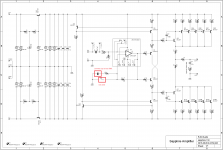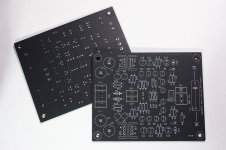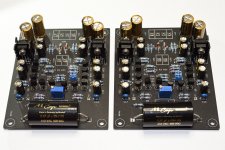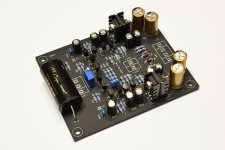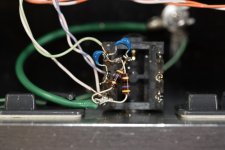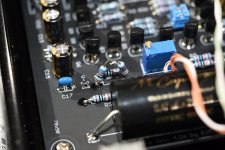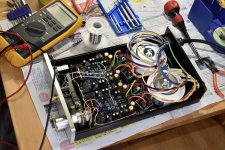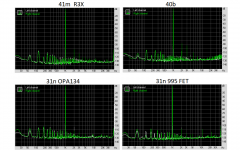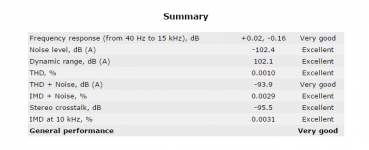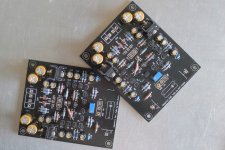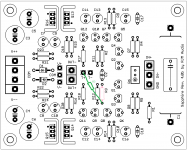Is there a list of discrete opamps that are known to be drop in replacements for the 3.1n? I've finally gotten around to piecing my boards together that have been sitting there for a year or so and it sounds great so far.
Right now I'm using an AD843 and figured it would be fun to try out one of those fancy discrete opamps like the burson or sparkos labs.
Right now I'm using an AD843 and figured it would be fun to try out one of those fancy discrete opamps like the burson or sparkos labs.
While anything with FET inputs is going to be fine, a discrete module with bipolar inputs isn't going to work without a modification to control the output offset voltage. Unlike ICs these circuits don't have the auxiliary function to cancel input offset currents and the input transistors are not sufficiently well matched do be capable of low output offsets without it.
There are several possible modifications, I think the simplest is to add a capacitor in series with R3A by connecting it at the SW1 pads. R3 is unused. This capacitor reduces the voltage gain at DC to unity, so there is no amplification of the input offset voltage.
Set capacitance as,
capacitance x R3A ~ 0.03 s
so about 22 uF for R3A 1.5k.
There are several possible modifications, I think the simplest is to add a capacitor in series with R3A by connecting it at the SW1 pads. R3 is unused. This capacitor reduces the voltage gain at DC to unity, so there is no amplification of the input offset voltage.
Set capacitance as,
capacitance x R3A ~ 0.03 s
so about 22 uF for R3A 1.5k.
Attachments
I haven't even cased up the 3.1n yet and now you show me this! Those are nice looking boards. Is that the final revision of the version 4?
Yes. The previous 4.0b was fine, so I just added a couple of convenience features in this respin: gain adjust jumper switch and an optional closed loop buffer connection.
Drop in replacement with all previous Sapphire boards if you ever decide to switch.
Drop in replacement with all previous Sapphire boards if you ever decide to switch.
tada~
Beautiful! Makes me want to build them again. But these should be sonically the same as my 4.0b prototype, right?
Definitely will sound no different from the prototype ... at least in the default. When you use R3X instead of R3 though the circuit has the buffer in the feedback loop and that's actually how I've wired mine up initially.
Connecting the buffer to drive the inverting input of the current feedback amplifier will theoretically lower distortion and increase bandwidth, at the expense of well, having to control that much more powerful negative feedback loop. So it will be interesting. I really liked my open loop 4.0b but felt that the second harmonic characteristics were a bit strong. If I could just tighten it up a little bit it would be perfect.
(note that version 3 with the op amp does not have the same need to put the buffer in the feedback loop as the op amp IC already has a powerful output stage designed to drive the feedback loop and the inverting input.)
@mlackey no, this is it. Either I will like the closed loop and use that or I'll convert the boards back to the open loop default. All the features and circuitry are settled and ... no ... I have no plans at all for a '5'.
Connecting the buffer to drive the inverting input of the current feedback amplifier will theoretically lower distortion and increase bandwidth, at the expense of well, having to control that much more powerful negative feedback loop. So it will be interesting. I really liked my open loop 4.0b but felt that the second harmonic characteristics were a bit strong. If I could just tighten it up a little bit it would be perfect.
(note that version 3 with the op amp does not have the same need to put the buffer in the feedback loop as the op amp IC already has a powerful output stage designed to drive the feedback loop and the inverting input.)
@mlackey no, this is it. Either I will like the closed loop and use that or I'll convert the boards back to the open loop default. All the features and circuitry are settled and ... no ... I have no plans at all for a '5'.
...All the features and circuitry are settled and ... no ... I have no plans at all for a '5'.
4.0b is awfully damn good. Extremely happy with it.
The closed loop configuration (what I'll call the "R3X mod") works great! As anticipated it's sounds something midway between the 3 and the open loop 4. Plenty of depth but more aggressive than the open loop 4.
Bench notes:
I ignored my own advice and instead of using a 5k trimmer as per the latest BOM figured I could get away with a 1k as before. Nope. npn/pnp difference means even with everything matched you'll see about -80 mV input offset voltage, requiring at least 2k trimmer to zero. I did a quick fix by adding 681 ohms to R5 to compensate.
I added a Zobel (47 ohms / 4.7nF) at the output "just in case".
One advantage of more feedback is a lower noise floor. It will be interesting to see what the measurements say but this thing is insanely "this is on right?" quiet even at maximum volume.
Bench notes:
I ignored my own advice and instead of using a 5k trimmer as per the latest BOM figured I could get away with a 1k as before. Nope. npn/pnp difference means even with everything matched you'll see about -80 mV input offset voltage, requiring at least 2k trimmer to zero. I did a quick fix by adding 681 ohms to R5 to compensate.
I added a Zobel (47 ohms / 4.7nF) at the output "just in case".
One advantage of more feedback is a lower noise floor. It will be interesting to see what the measurements say but this thing is insanely "this is on right?" quiet even at maximum volume.
Attachments
Last edited:
and the results are in...
The big story is the 41m has the lowest noise floor of all versions so far, by about 2 dB over the FET995 and 4 dB over the 40b and OPA134 fronted 31n.
(Unloaded) distortion is of course is big improvement over the 40b, but the surprise here is it matches even the discrete op amp versions of 3.1n and betters both in inter-modulation distortion.
All in all a *very* impressive set of specs.
The big story is the 41m has the lowest noise floor of all versions so far, by about 2 dB over the FET995 and 4 dB over the 40b and OPA134 fronted 31n.
(Unloaded) distortion is of course is big improvement over the 40b, but the surprise here is it matches even the discrete op amp versions of 3.1n and betters both in inter-modulation distortion.
All in all a *very* impressive set of specs.
Attachments
Last edited:
"...mesmerized by a feedback circuit..." (1959, the BBC)
Well, shucks. I guess I'll have to retool for 4.1m.
Now, not to poke fun at anyone in particular, but this is too "a propos" to be ignored. You must see the video at this link from today's newsletter from Paul McGowan:
https://twitter.com/i/videos/tweet/852128571120381954
Too much fun! "Steereo"
and the results are in...
The big story is the 41m has the lowest noise floor of all versions so far, by about 2 dB over the FET995 and 4 dB over the 40b and OPA134 fronted 31n.
(Unloaded) distortion is of course is big improvement over the 40b, but the surprise here is it matches even the discrete op amp versions of 3.1n and betters both in inter-modulation distortion.
All in all a *very* impressive set of specs.
Well, shucks. I guess I'll have to retool for 4.1m.
Now, not to poke fun at anyone in particular, but this is too "a propos" to be ignored. You must see the video at this link from today's newsletter from Paul McGowan:
https://twitter.com/i/videos/tweet/852128571120381954
Too much fun! "Steereo"
Last edited:
Negative feedback. It's-only-wrong-when-someone-else-uses-it.(tm) Seriously though after all the badmouthing it gets I'm a little shocked the R3X mod actually worked. (not that open loop sounds bad or anything, the opposite, its just so far as personal preference goes it was a bit too much of a beautiful lie.)
Stan: free set of 4.1m boards, reward for superior guineapigness. Drop me a pm to confirm you want them.
Stan: free set of 4.1m boards, reward for superior guineapigness. Drop me a pm to confirm you want them.
Some comments on what the 41m (R3X) version sounds like:
For me, audio design is 90% engineering and 10% alchemy. You need to clear the engineering bars first for low noise and accuracy but it's the non-quantifiable characteristics that ultimately come to define whether you will enjoy the circuit or not.
First for the quantifiable, the lower noise floor does give it an edge in resolution over previous iterations. Coupled with pinpoint stereo accuracy the illusion of physical space, the virtual reality aspect headphones can throw up seems far more effortless than before.
In terms of character though, it is not vastly removed from my previous "best", the 3.1n with 995FET modules. It's similarly clean, smooth, and dynamic. The difference is where the '995 is blandly accurate the R3X is accurate but anything but bland. There is the same element of that technicolor augmented reality I heard with the 4.0b, but it's touch is so light that I don't feel I'm missing anything this time. If that's the drug, I'm buying. "Listening experience" - we say those words to justify the hobby but how often is it we actually get the experience and not merely just listen?
I could pick any number of examples where the amp pretty much floored me, but to highlight one: high hat, cymbals, snare - a lot of your better amps can get the snap and sparkle more-or-less right (bad amps will just give distorted crackle) but none that I can think of can give you that liquid-like shimmer you hear in live performances. So, that. This amp can do that. I don't know if it is an illusion or a faithful reproduction of the recording, and I don't care. Either way I'll take it!
For me, audio design is 90% engineering and 10% alchemy. You need to clear the engineering bars first for low noise and accuracy but it's the non-quantifiable characteristics that ultimately come to define whether you will enjoy the circuit or not.
First for the quantifiable, the lower noise floor does give it an edge in resolution over previous iterations. Coupled with pinpoint stereo accuracy the illusion of physical space, the virtual reality aspect headphones can throw up seems far more effortless than before.
In terms of character though, it is not vastly removed from my previous "best", the 3.1n with 995FET modules. It's similarly clean, smooth, and dynamic. The difference is where the '995 is blandly accurate the R3X is accurate but anything but bland. There is the same element of that technicolor augmented reality I heard with the 4.0b, but it's touch is so light that I don't feel I'm missing anything this time. If that's the drug, I'm buying. "Listening experience" - we say those words to justify the hobby but how often is it we actually get the experience and not merely just listen?
I could pick any number of examples where the amp pretty much floored me, but to highlight one: high hat, cymbals, snare - a lot of your better amps can get the snap and sparkle more-or-less right (bad amps will just give distorted crackle) but none that I can think of can give you that liquid-like shimmer you hear in live performances. So, that. This amp can do that. I don't know if it is an illusion or a faithful reproduction of the recording, and I don't care. Either way I'll take it!
... that liquid-like shimmer you hear in live performances. ... This amp can do that. I don't know if it is an illusion or a faithful reproduction of the recording, and I don't care. Either way I'll take it!
When I was auditioning 4.0b, I listened to Bill Evans, The Complete Village Vanguard Recordings, 1961. I recall being struck by how utterly realistic the background club noise was. It's just an under-current beneath the music, but, I think I had never heard it so convincingly convey the sense of the night club space in which Evans was playing. "liquid-like shimmer" is an apt descriptor.
When I was auditioning 4.0b, I listened to Bill Evans, The Complete Village Vanguard Recordings, 1961. I recall being struck by how utterly realistic the background club noise was. It's just an under-current beneath the music, but, I think I had never heard it so convincingly convey the sense of the night club space in which Evans was playing. "liquid-like shimmer" is an apt descriptor.
Stan, so are you implying the 4.0b version could very well be the "Holy Grail" and best sounding of Richard's "Sapphire" boards, or do you think there may still be room for SQ improvement in the 4.1m boards?
For someone who's been following this thread, it's certainly confusing since each newer version seems to be "better" than the previous version.
Thanks.
To interrupt if I may -
They are exactly the same circuit, the 41m has the options for closed/open loop built in while the earlier board did not. Stan is listening open loop, I have set mine as closed loop.
We are describing the same thing, its a question of degree: it is more pronounced open loop, somewhat less so closed loop. I know this because I also evaluated open loop with the earlier 40b revision. With the new boards you can try out both, and have a gain switch besides - there's no reason to choose 40b over 41m now - which is a good thing since there are no 40b left now anyways!
That said, I have my set of 40b boards fully built that I can send out for a nominal cost. They are currently configured 27 dB closed loop (it's a mod with a flying resistor connection). They boards are a little ratty but serviceable. pm if interested.
They are exactly the same circuit, the 41m has the options for closed/open loop built in while the earlier board did not. Stan is listening open loop, I have set mine as closed loop.
We are describing the same thing, its a question of degree: it is more pronounced open loop, somewhat less so closed loop. I know this because I also evaluated open loop with the earlier 40b revision. With the new boards you can try out both, and have a gain switch besides - there's no reason to choose 40b over 41m now - which is a good thing since there are no 40b left now anyways!
That said, I have my set of 40b boards fully built that I can send out for a nominal cost. They are currently configured 27 dB closed loop (it's a mod with a flying resistor connection). They boards are a little ratty but serviceable. pm if interested.
Last edited:
- Home
- Amplifiers
- Headphone Systems
- RJM Audio Sapphire Desktop Headphone Amplifier
